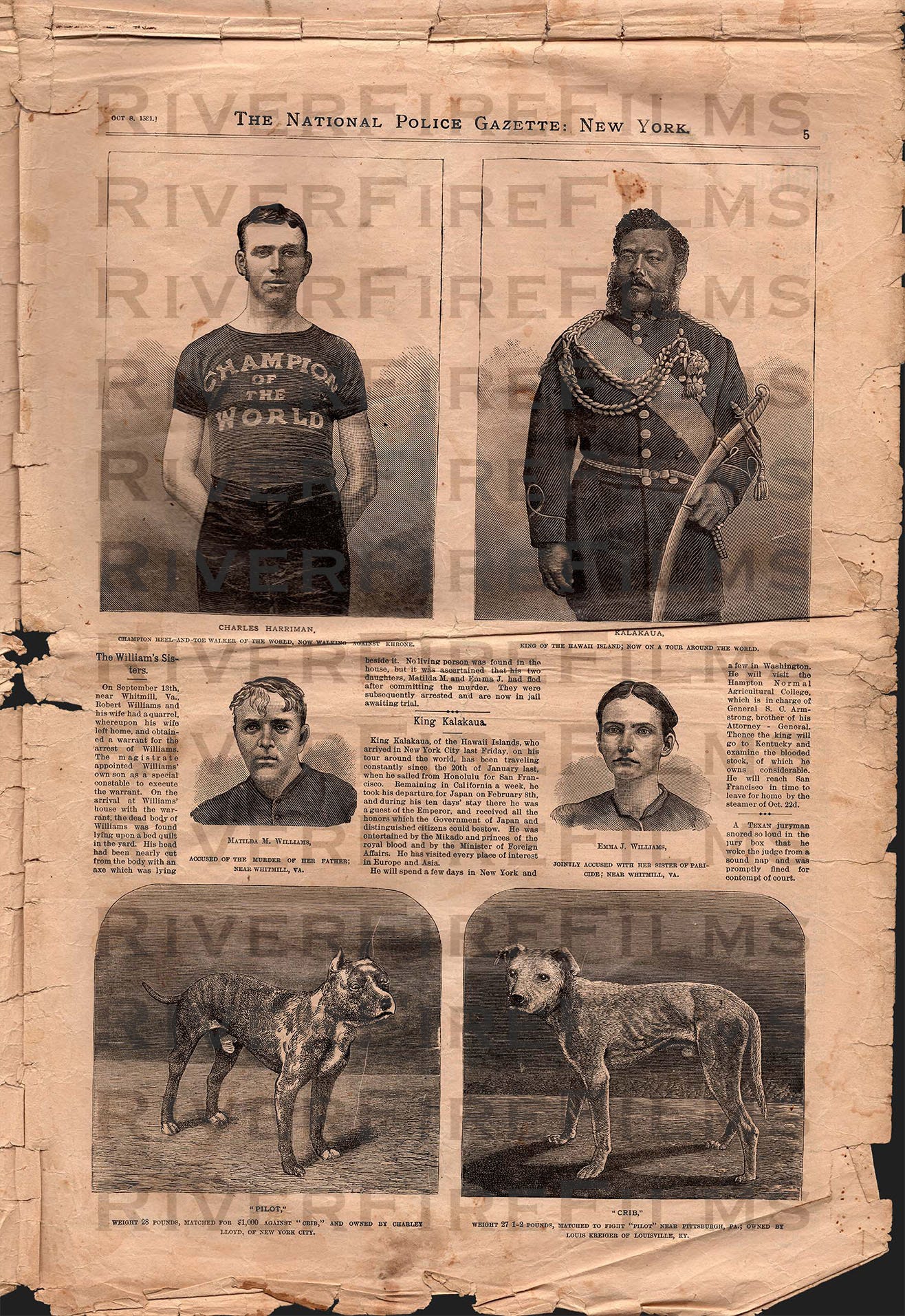The rise of the American dogfighter
Despite the controversial and uncomfortable nature of this specific subject matter, in the 5th edition of The Archives we examine a page from The National Police Gazette - published on October 8, 1881, about a famous dogfighting match between Lloyd’s Pilot and Krieger’s Crib.
Setting aside personal feelings and beliefs, the significance of this artifact is it’s the exact moment interest in dogfighting spiked in popularity in the United States, post-Civil War. And, that is incredibly important to understand because of the lasting impact it had on breeders of gamebred pit bull terriers, who after nearly 150 years still reference the match between these two dogs.
Louis Krieger proposes his challenge
It all started with Louis Krieger, of Louisville, Kentucky, who sent in a challenge to the Sporting Editor of the National Police Gazette, which published it in the July 16, 1881 issue -
“To the Sporting Editor of the Police Gazette: I have two dogs I will fight at weights respectively 28-pounds and 18 pounds. I will fight the 28-pound dog for $1,000 a side, and the 18-pound dog for $500 a side…”
The 28-pound dog - Crib, was proclaimed to be ‘the greatest dog in America’ at the time, and was favored to win.
The challenge was accepted by an Englishman named, Charley Lloyd, of New York, who went by ‘Cockney Charley’. He agreed to match his 28-pound, brindle and white, bull-and-terrier, named Pilot, who was imported into the U.S. from England, bred by a famous breeder, John Holden of Walsall, in the historic county of Staffordshire.
On September 1st (1881), terms of the agreement were written out and published in the Police Gazette, and a date was set for October 19, 1881 and take place in Kentucky. The winner would claim the title of the first American Championship. Lloyd was quoted in the article about the upcoming fight:
“More money has been bet on the result than any dog fight that has ever taken place in America or England to my recollection, and I have been in this business forty years.”
Pilot went on to defeat Crib, fatally wounding him after one hour and twenty-five minutes. This made his value increase as a stud dog, immediately become in high demand. So much so, that his name can be found peppered in pedigrees of the foundational stock of some of the most well known breeders in the development of what would soon become the American Pit Bull Terrier at the turn of the century.
The ASPCA forms; dogfighting goes underground
It’s important to note, laws across the board that protected animals were still very new post-Civil War. They mainly protected horses and cattle, in ways that forbid someone else to harm someone’s horse or cow. But, that was all about to change.
In April of 1866, a man named Henry Bergh founded the American Society for the Prevention of Cruelty to Animals (ASPCA). His primary target was a man named Kit Burns - owner of ‘Sportsmen’s Hall’ in New York City, where dogfights, cockfights and ratting contests were held.
Bergh was making apparent progress, as he and his agents raided Burns and others, until eventually they were shut down. At one point, he thought he had eliminated dogfighting completely within New York City because there were no more establishments like Burns’ Sportsmen’s Hall left.
But, as “The Pit Bull: Fact and Fable”, published in 1984, pointed out so succinctly, Bergh’s efforts actually pushed the organized dogfighting fraternity outward. Where it was once prominent in New York, Boston, and the New England region, was now being spread into the south and west.
Kit Burns wasn’t Bergh’s only target. He also followed around the Englishman from New York, Charley ‘Cockney’ Lloyd. Once he was made aware of Pilot and Crib’s scheduled match, Bergh sent officers to shadow Lloyd’s whereabouts for weeks in Kentucky and Ohio.
Upon the conclusion of the fight, on October 29, 1881 the Brooklyn New York Daily Union-Argus reported that a Grand Jury indicted Charley Lloyd and Louis Krieger.
Lloyd, apparently, fled to Boston after the fight. Two months later, on Christmas Eve (1881), Lloyd issued a challenge via the Police Gazette promoting the opportunity to match against his now famous dog, Pilot.
About the Newspaper
The National Police Gazette was a weekly newspaper that originated in 1845, and began by chronicling crime and criminals.
Nearly thirty years later, it was sold to a man named Richard K. Fox, who turned it into a hugely successful men’s lifestyle tabloid. He ran the paper as Editor and Proprietor from 1877 until his death in 1922.
Under his guidance, the Police Gazette soared in popularity and was immensely influential. It was one of the first publications to tap into the curiosities of murder and mayhem, while also covering the country’s increasing interest in sports, especially professional boxing, for which it sanctioned matches for world champion title fights. He also published dogfights.
About “The Archives”
The Archives is a special blog series, which explores the complicated past of pit bull terriers through historical photographs, newspapers, and other vintage artifacts.
This project is part of the documentary film – Once In A Lifetime, and each item is preserved in high resolution scans of the original and made available exclusively on the Politics of Pit Bull Dogs Substack.
To view all posts for “The Archives”, go to:
https://riverfirefilms.substack.com/t/the-archives
resources:
Louis Krieger | Find A Grave






